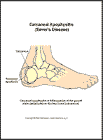
Calcaneal Apophysitis (Sever's Disease)
What is calcaneal apophysitis?
The heel bone is called the calcaneus. In children, there is an area on the heel bone where the bone grows that is called the growth plate, or apophysis. Calcaneal apophysitis, also called Sever's disease, is inflammation of the calcaneal growth plate that causes pain in the heel. It is the most common cause of heel pain in children, adolescents, and teenagers.
How does it occur?
This inflamed heel growth plate is caused by overusing the foot with repetitive heel strikes. It may also occur from wearing shoes with poor heel padding or poor arch supports.
What are the symptoms?
A child will complain of heel pain. Running and jumping usually increase the symptoms.
How is it diagnosed?
The health care provider will find tenderness over the bottom part of your child's heel. In severe cases of calcaneal apophysitis, he or she may order an x-ray to be sure there is no damage to the growth plate.
How is it treated?
Your child may need to rest or do activities that do not cause heel pain. It is very important that your child wear shoes with padded heel surfaces and good arch supports. Extra heel pads may be placed in your child's shoe. Orthotics (custom-made arch supports) may be helpful. The health care provider may also prescribe an anti-inflammatory medication for your child.
When can my child return to his or her sport or activity?
The goal of treatment is to return your child to his or her sport or activity as soon as is safely possible. If your child returns too soon the injury may be made worse, which could lead to permanent damage. Everyone recovers from injury at a different rate. Return to his or her activity will be determined by how soon your child's heel recovers, not by how many days or weeks it has been since the injury occurred. In general, the longer your child has symptoms before starting treatment, the longer it will take to get better.
If the heel hurts, your child needs to rest from his or her sport or activity. Your child should rest for several days at a time and then go back gradually. Before returning, he or she should be able to jog painlessly, then sprint painlessly, and be able to hop on the injured foot painlessly. If at any time during this process your child develops further heel pain, he or she should rest for 3 to 4 more days until the pain is gone before trying to return again.
How calcaneal apophysitis be prevented?
Calcaneal apophysitis is best prevented by having your child wear shoes that fit properly. The heel portion of the shoe should not be too tight, and there should be good padding in the heel. You may want to put extra heel pads in your child's shoes.
Some children simply get too much physical activity (such as playing on too many teams, practicing for hours, etc). Their heel pain is a message to slow down.

